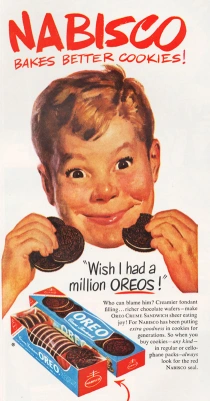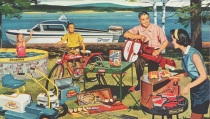The idea of upward mobility in America is a powerful and deeply ingrained part of the American Dream.
Never was the American Dream more potent or more seductive than in Mid century America. Middle class American were the most envied people on earth, and our faith in social mobility was at its zenith.
By the early 1950s, a new middle class society had emerged. The victorious vets had come home from the war, gone to college on GI Bills, bought suburban homes with help from Uncle Sam, and found jobs in the rapidly expanding corporate world.
At the same time, the Mad Men of mid-century Madison Avenue cleverly created advertising campaigns calculated to sell the American dream to the world and to ourselves.
Hawking the American Dream as much as they sold brand loyalty to beer, cameras or coca cola the ads both reinforced and reflected the fairy tale suburban life, offering a template to the newly minted post-war middle class.
A Toast To Ourselves
One such ad campaign was a series of advertisements called “Home Life in America” that ran from 1946-1956 showing an idealized Mid Century America enjoying their post-war promises of prosperity.
The idyllic illustration by Americas leading illustrators all portrayed an eerily homogenous landscape of spacious homes and smiling prosperous self-satisfied Anglo-Saxon families.
TV’s June and Ward Cleaver or Jim and Margaret Anderson would have fit right at home in any of these dozens of tableaus of the American dream.
The creators of this picture perfect suburban America was not wholesome Coca cola but the United States Brewers Foundation (USBF), a trade group of breweries.
They hoped through the campaign to change the somewhat dubious reputation of beer moving it seamlessly away from the seedy saloon into the spic n’ span suburban home where it would become part of the perfect suburban lifestyle of good wholesome fun.
A Cold War Brewsky
Published during the deep freeze of the cold war, these warm and fuzzy tributes to the good life naturally emphasized themes of freedom and patriotism.
Uncle Sam was certain that the Communists were waging a campaign of hatred against us and our peaceful decent motives.
Convinced that the Russians had embarked on an aggressive campaign to destroy our government , establishing the American Way of Life as ideal became even more crucial during this time contrasting it to the ruthless Godless Communist way of repression
The jingoist ad copy emphasized the goodness of America, and an appreciation for our country and what it stands for
“In this home loving land of ours” the ads begin,”…in this America of kindliness, of friendship, of good-humored tolerance..perhaps no beverages are more “at home” on more occasions than good American beer and ale.”
“For beer and ale are the kinds of beverages Americans like. They belong- to pleasant living to good fellowship to sensible moderation. And our right to enjoy them, this too belongs-to our own American heritage of personal freedom.”
The suburbs and home ownership were freedom, wealth, happiness, personal fulfillment and enjoying a cold war brewsky at home was now part of the picture.
In This Friendly Freedom Loving Land of Ours

Taglines used in virtually ever ad were “Beer belongs” a shortened version of “In this friendly freedom loving land of ours-beer belongs…enjoy it.”The ads seemed to transcend the conflicts at the time, the vanished golden days of the middle class. Of course there were people outside the consensus Blacks were basically banned from the suburbs. Vintage Beer Ads Home Life in America Series (L) “Vacationers Reunion” by Douglass Crockwell 1953 (R) “Dad Takes On the Comers” Douglass Crockwell 1954

By 1950 a million new homes had been built to accommodate first time home buyers returning vets, and their new families. They visited model homes selected payment plans chose appliances from the builder brochure and ads were a template for these newly minted middle class suburbanites

The vets and their new wives wanted housing. More specifically they wanted it in the suburbs. Between the Depression the decaying urban infrastructure and rising crime, the city seemed to have lost it’s hold on the American imagination. Vintage Beer Ads Home Life in America Series (L) “Around the Swimming Pool” by John Gannam 1948 (R) “Friends Over for Tennis” by Douglass Crockwell 1949

William Levitt,the genius behind Levittown, put it most succinctly”:No man who owns his own house and lot can be a communist. He has too much to do.” Vintage Beer Ads Home Life in America Series (L) “Getting the Boat Ready” by Douglass Crockwell 1950 (R) “Weekend in the Country” by Austin Briggs 1948

Beer was portrayed as part of American social life. Home ownership was part and parcel of the American dream, believed to create stabler happier citizens. Vintage Beer Ads Home Life in America Series (L) “Quiet Evening at Home” by Douglass Crockwell 1955 (R) “Between Innings” by Pruett Carter 1955

Vintage Beer Ads- Home Life in America Series (L) “Thanksgiving Dinner” by Douglass Crockwell 1949 (R) “An Evening of Cards” by Douglass Crockwell 1954
But a lot has changed
The American dream has long been dictated by the professional middle class. It is little wonder that today both Mitt Romney and President Obama are courting the beleaguered middle class voter many of whom fear that the American dream is slipping away for themselves and their children.
The brewing of the American Dream has gone flat.















Pingback: Rosie the Riveter Gets Her Pink Slip « Envisioning The American Dream
What’s also interesting — but hardly surprising for the period — not a single black, Asian or Hispanic face in any of these wholesome ads all about the freedom of America.
LikeLiked by 1 person
Very true. It kept reminding people about the cultural link between the US and west European countries. And it also certainly impact other countries such as Canada, New Zeland those pre-British colonies. These countries almost has the same image like the US in people’s mind of the 3rd World. I feel that this reflects the social circle of the makers of “American Dream”.
LikeLiked by 2 people
Pingback: American Dream Doesn’t Add Up | Envisioning The American Dream
Pingback: A Soaring Economy | Envisioning The American Dream
Pingback: How the American Dream Grew | Envisioning The American Dream
Pingback: Lagom: How Scandinavians find Balance | Pine Tribe
From my aspective, people immigrated from the so-called “the 3rd World” to many other countries after WWII, like Canada, Austrilia, are also having an illusion about “American Dream”.
LikeLiked by 1 person
Pingback: A Blueprint For The Middle Class | dominicwordpresscomblog
These illustrations portray an America that never really was but one that those who view the past through rose-colored glasses insist once existed. Mid-century, post-WW2 America was hardly the utopia that these ads seem to indicate. Notice how the characters are all smiling, well-dressed and with nary a hair out of place. Everything is just so and all’s right with the world in these Father Knows Best type sitcoms on canvas. That said, I find them fun to look at and even comforting in a way.
LikeLike
Pingback: Suburban Housing vs. Settlement Housing – The Fourth Estate